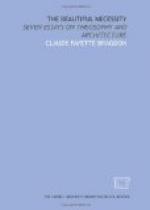[Illustration 93]
It is a demonstrable fact that musical sounds weave invisible patterns in the air. Architecture, correspondingly, in one of its aspects, is geometric pattern made fixed and enduring. What could be more essentially musical for example than the sea arcade of the Venetian Ducal Palace? The sand forms traced by sound-waves on a musically vibrating steel plate might easily suggest architectural ornament did not the differences of scale and of material tend to confuse the mind. The architect should occupy himself with identities, not differences. If he will but bear in mind that architecture is pattern in space, just as music is pattern in time, he will come to perceive the essential identity between, say, a Greek rosette and a Gothic rose-window; an arcade and an egg and dart moulding (Illustration 94). All architectural forms and arrangements which give enduring pleasure are in their essence musical. Every well composed facade makes harmony in three dimensions; every good roof-line sings a melody against the sky.
[Illustration 94: ARCHITECTURE AS PATTERN]
CONCLUSION
In taking leave of the reader at the end of this excursion together among the by-ways of a beautiful art, the author must needs add a final word or two touching upon the purpose and scope of these essays. Architecture (like everything else) has two aspects: it may be viewed from the standpoint of utility, that is, as construction; or from the standpoint of expressiveness, that is, as decoration. No attempt has been made here to deal with its first aspect, and of the second (which is again twofold), only the universal, not the particular expressiveness has been sought. The literature of architecture is rich in works dealing with the utilitarian and constructive side of the art: indeed, it may be said that to this side that literature is almost exclusively devoted. This being so, it has seemed worth while to attempt to show the reverse of the medal, even though it be “tails” instead of “heads.”
It will be noted that the inductive method has not, in these pages, been honored by a due observance. It would have been easy to have treated the subject inductively, amassing facts and drawing conclusions, but to have done so the author would have been false to the very principle about which the work came into being. With the acceptance of the Ancient Wisdom, the inductive method becomes no longer necessary. Facts are not useful in order to establish a hypothesis,




